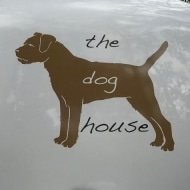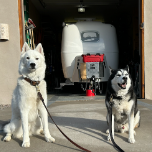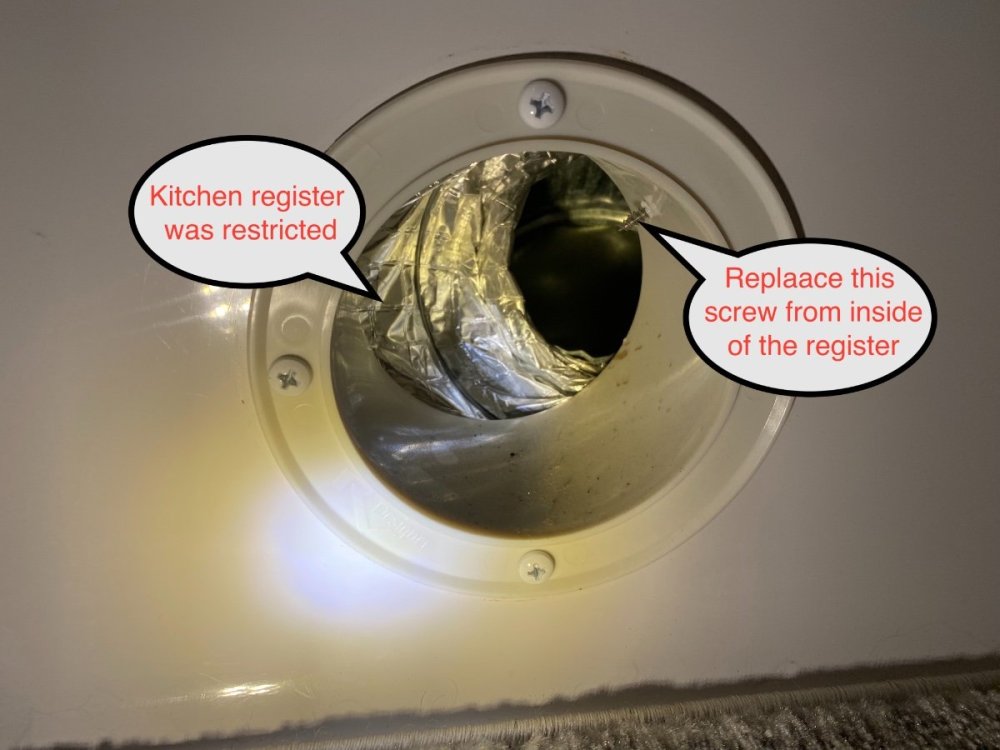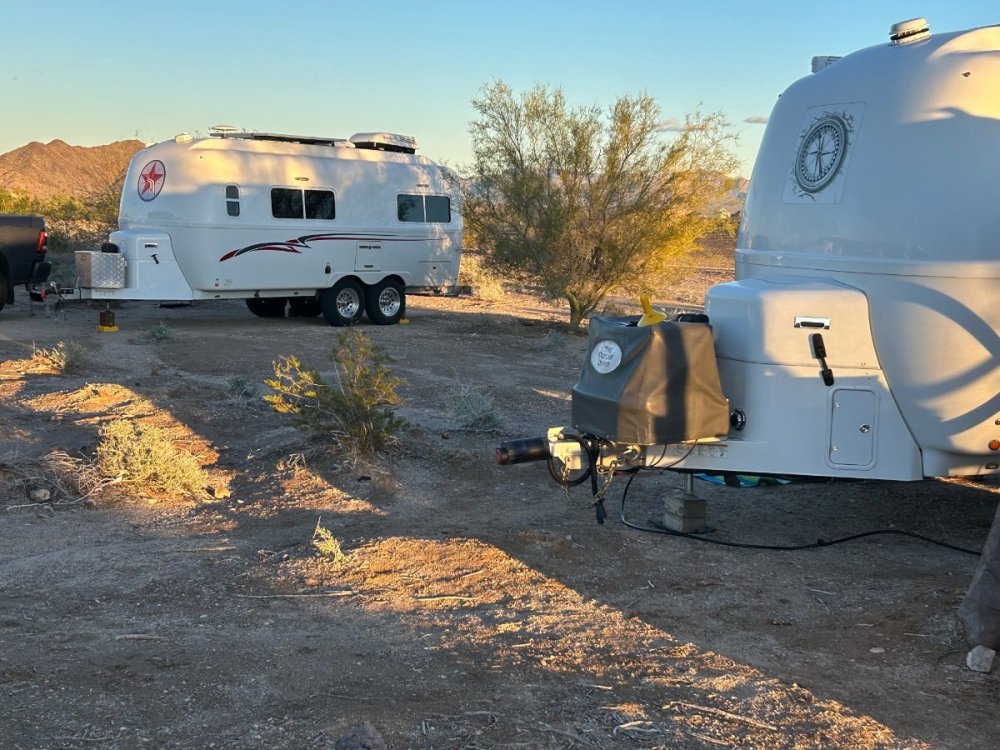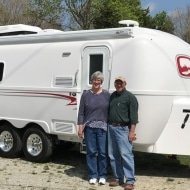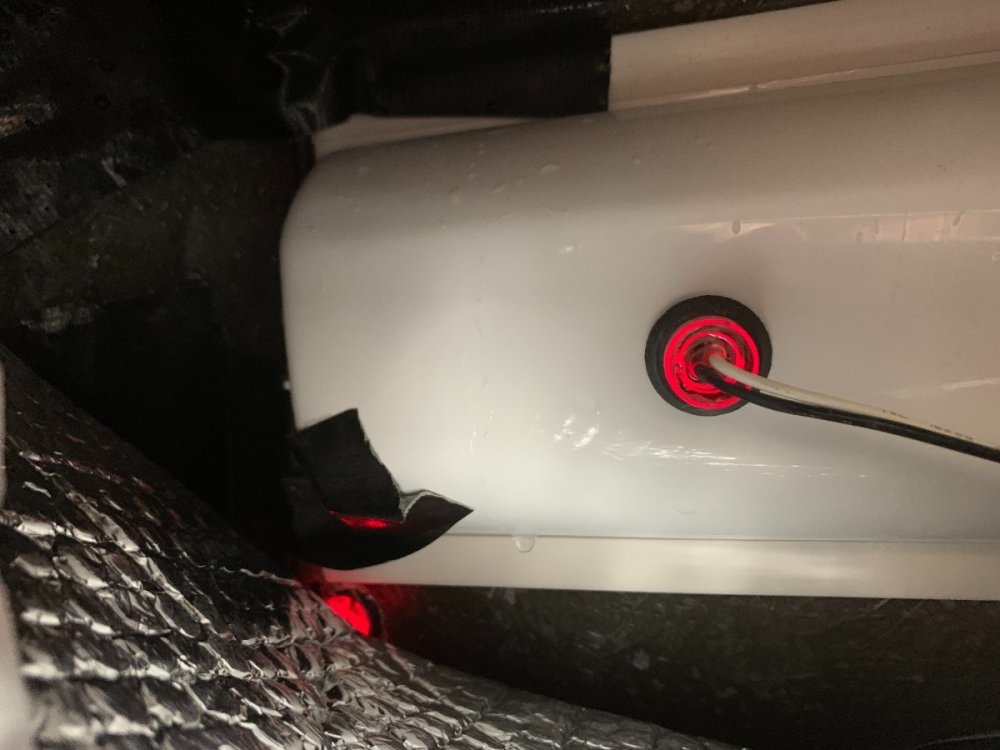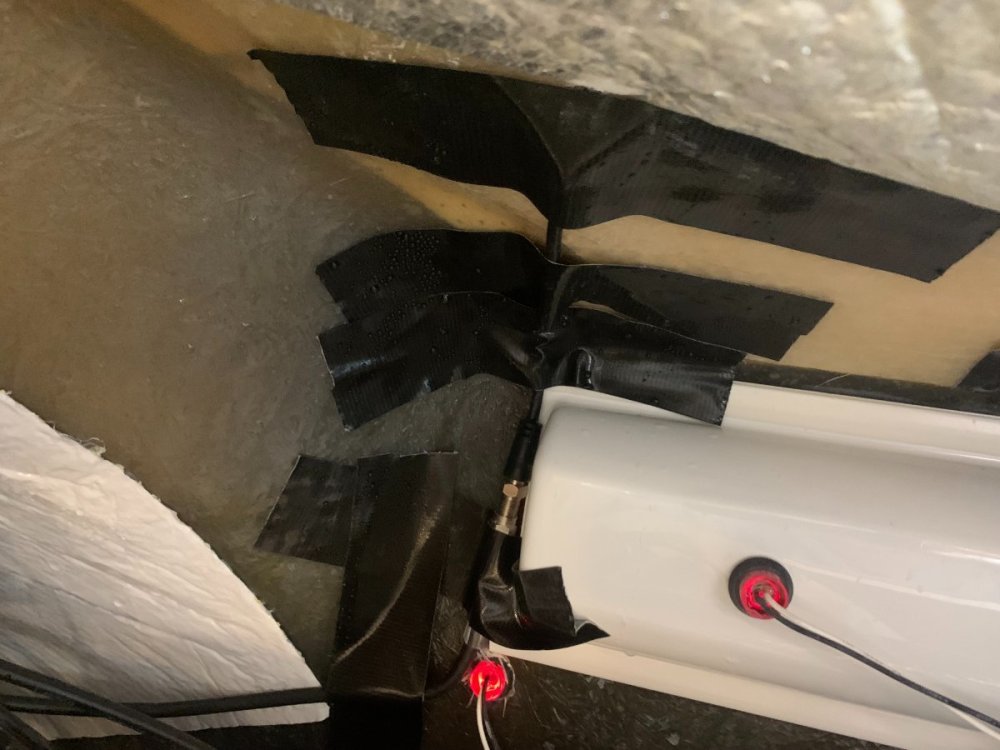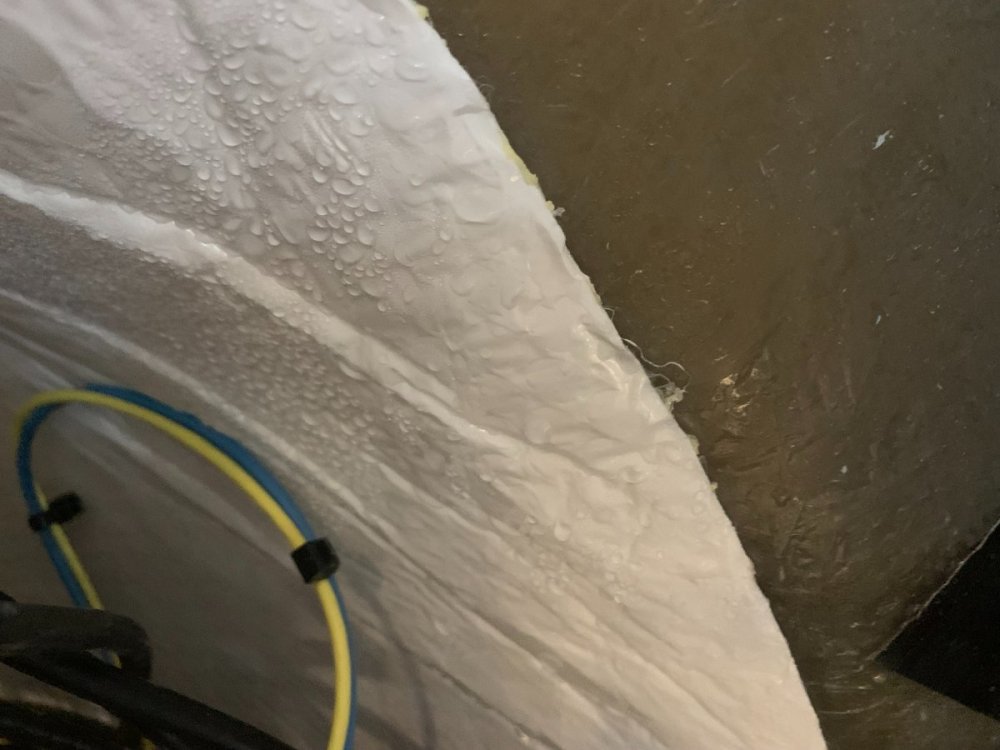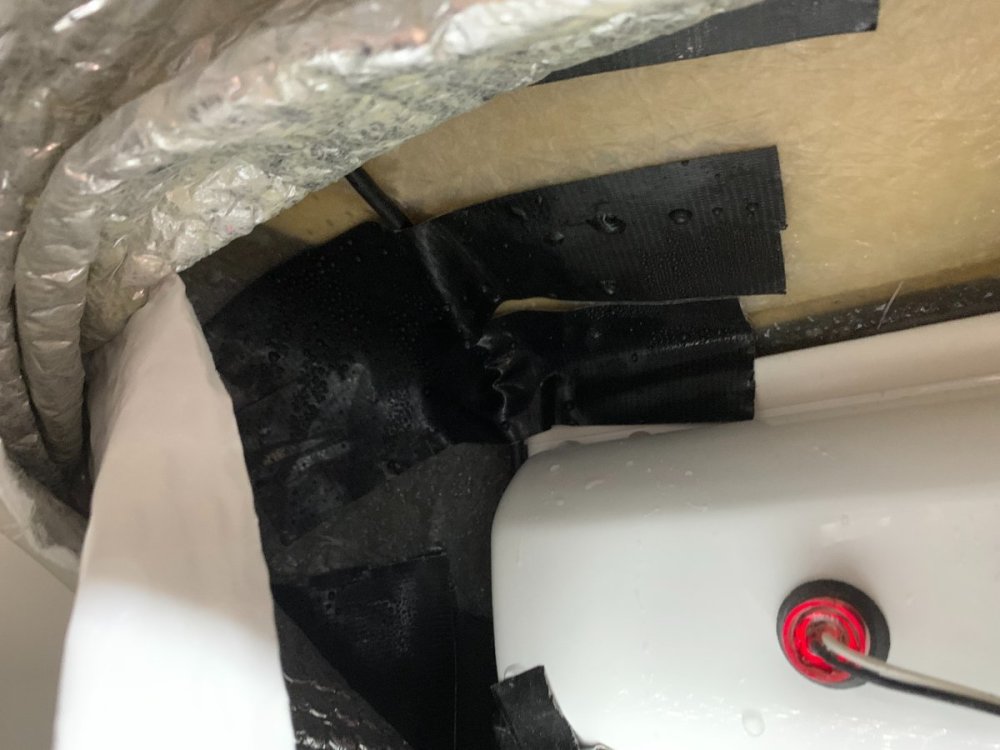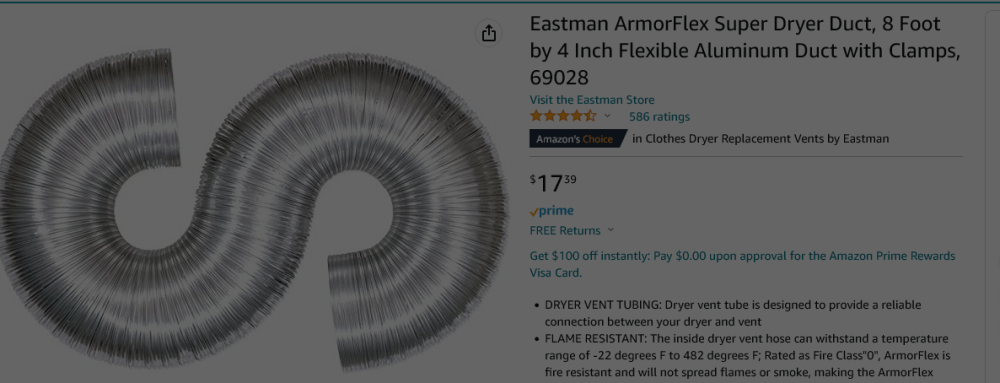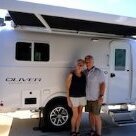Leaderboard
Popular Content
Showing content with the highest reputation on 02/07/2024 in all areas
-
Kirk, yes, all the storage areas are heated. Water control compartment, exterior shower, battery locker, big gear garage, etc.. We put up a clothes rack and dry our kayak and ski clothing in there. As to heating efficiency, we bought VanMade inserts for those big windows in the Transit. There is also an included insulated curtain that snaps in to block off the entire cockpit which we use overnight when temps are below 10 degrees. Apples to orange but, in single digit temps, when boondocking with water system on, we go through a 20lb tank of propane every 3 + days. In our Oliver E2, winterized (= no water in system) , boondocking, we went through a 30lb tank every 2 days. The Oliver used propane for the fridge and had no water to heat while the Ekko has a 12v fridge, heats all exterior compartments and water heater. On another note, I think crafty Oliver owners have been great about improving cold weather capacity and the manufacturer themself has started adapting some of these mods but, in my experience, Oliver is now about the best reasonably priced trailer out there for cool weather use. Without the price shooting way up, it's the best trailer available.4 points
-
Are you sure you didn’t use some for backing on your fly reel? Mossey3 points
-
Promise not to laugh!😂 From my post of October, 2023 above I "finally" got a chance to get back to that shade on the floor of my workshop. No, I'm not completely finished yet - don't want to rush it - but I'm close. In fact, I'm close enough to to let everyone know that it takes between 14.5 and 15 feet of string to complete one side of the whole deal - that is either the night shade OR the day shade. Obviously, both sides would take double that or up to 30 feet of string! That amazed me - where in the world does all that string go? Bill3 points
-
Good question. For those not up on this unit, the Sprekko is on a Sprinter platform, 2-3' longer and $20k more. I got the Trekko which is on a Transit platform. Prefer that for ease of finding qualified repair places and smaller footprint. Rich.dev, you may have stepped into a real pile of trouble if you had picked up one of the early models. They were filthy with recalls and poorly installed systems. Later models have been much better about minimizing the kinks.3 points
-
There are pros and cons with the Oliver. It's a company that only makes one type of product (Elite 2 is just a stretched Elite 1). Yes there are cool options, but it's basically one product. If it fits your style, you're in luck. If not, there are many other RVs, and many companies that offer multiple products. Many of us have made minor or major modifications, but ultimately your camping style has to match the trailer. For most of us, it's a match made in heaven.2 points
-
Yes, it's directly attached to the Tee for the kitchen register. The 3" duct goes on to the bathroom through some sort of firewall and it's not easily reached. There was enough slack in the 3" duct to pull the Tee (with attached reducer) out through the access port that's under the forward kitchen drawers. The space is tight, and you will need to detach the 4" side from the furnace to get enough slack on that side. You can make most of the new connections while it's out. You'll need to disconnect the kitchen register first. The screw holding the duct to the register can be reached through the access port, but it's easier to replace it from the inside of the register, rather than trying to do it blindly from inside the access port. Cheers, Geoff Here's a photo that I forgot to add in the original post:2 points
-
2 points
-
Yep, the GX is a great vehicle, but not for towing the LE II. The LX is actually better than my Land Cruiser, due to the self leveling system and height adjustment. No need for the Firestone airbags with the LX.2 points
-
Congrats Gerry! We also looked at the Ekko, but at that stage the Ekko was still in its infancy stage, so we decided on the Oliver. Did you end up getting the Sprekko or Trekko!2 points
-
We ended up going with a Winnabego Ekko. Couldn't be more of a different animal. Similarities in length, width, fiberglass exterior and it has wheels. That's about it. Gets the same MPG as my 2022 F150 did while towing. Absolutely not the same build quality or sense of interior open space as the Olivers. Also not molded fiberglass so will need to keep an eye on seams. On the flip side: Better driving on snow (AWD) as opposed to towing and have heard folks claim comfortably at -40. More storage for toys - I think comparable to Oliver and full sized truck bed with cap filled to the hilt. Cassette toilet as opposed to our composter which is different but working out fine. 50 gallon fresh tank, innovative convertible bathroom design, 640ah of lithium, ducted AC and a dedicated alternator for charging batteries at 160a while driving. Replaced my truck with a Honda Fit (the sensible guy's mid-life crises sports car) which we could and sometimes will flat tow behind the rig. We found a unit with 3k miles on it and it ended up costing twice what we paid for our E2 in '21. Hmmmm. Would be a questionable purchase were it not for the better fit with our camping style. Long trips but short stays at any one place. Oliver was certainly a more luxurious and open space with Ekko being more of an "adventure" platform. Every time we turn the key we are focused on some combination of skiing, kayaking, mountain biking, snowshoeing, etc... We mourn the passing along of our Oliver and feel it felt more like a home away from home. It's very likely that once we get over our outside toy addiction, we'll may circle back around. Wish we could have kept both. Thanks very much to you all. We are deeply appreciative that you would welcome a couple of Benedict Arnolds to stay in the group. We follow quite a few such forums and feel this is the best informed and supportive of all. Hope to see you all out there.2 points
-
Like others, we’ve been disappointed with the lack heating in the bathroom. In our Oliver, even the kitchen had minimal air flow and hot air was blasting under the bed. When I took a closer look at the duct routing from the furnace, the problems became obvious. There were two 4” ducts coming out of the furnace, one from the front outlet facing towards the registers, and the other from the rear outlet facing away from the registers. The front outlet was connected to the bedroom register with one 900 bend. It had the shortest run with the least turns, and twice as much air flow as the other two combined. The rear furnace outlet was connected to the kitchen register after making a 1800 u-turn. From there it was Tee’d and reduced to 3” to feed the bathroom. The 3” duct then takes a long and torturous path to reach the bathroom. The resistance from over 2800 of turns, and the longer run, resulted in much lower air flow to both the kitchen and the bathroom. I also found a hole from where the duct had been rubbing on the hot water valve, and the kitchen had a restrictively tight bend at the register. Fortunately this was a relatively easy fix, and the results were significant. Our 2022 Elite II has the Dometic furnace, but I suspect that other furnace brands could have similar ducting issues and it might be worth taking a look. The sketch shows how the duct routing was modified for better balance to all three registers. The bedroom and kitchen registers now feed from the high resistance u-turn at the rear furnace outlet. The bathroom has its own feed from the front outlet giving it the minimal number of turns possible. This modification involved moving the Tee which is under the kitchen cabinet. There is an access port under the forward kitchen drawers to reach the Tee and kitchen register, and it’s best to pull them right out of the access port to work on them. The 3” bathroom reducer stays in place and it gets a new duct directly to the front furnace outlet. The bedroom/kitchen gets connected to the rear furnace outlet. Rather than using flexible duct to make the 1800 u-turn, I used two 900 rigid fittings for less flow resistance. All of the parts needed for this modification are readily available at hardware stores. They usually sell duct by the foot, I bought 5’. Use sheet metal screws and foil duct tape for the connections to make sure they don't come apart. The kitchen register can be screwed together from the inside of the register rather than trying to do it from under the cabinet. I used an anemometer before and after the modification to measure flow, and a on-line calculator was used to get Cubic Feet per Minute (CFM): Before After Bedroom - 4” 100.7 53.2 Kitchen - 4" 39.3 65 Bathroom - 3" 11.8 30.2 Total 151.8 148.5 Cheers, Geoff1 point
-
1 point
-
1 point
-
I'm thinking a 4" Valterra vent between the forward dinette seat through the bathroom bulkhead near the toilet would be just as efficient, IMO.1 point
-
1 point
-
1 point
-
That pretty much describes just about every other RV out there. They look flashy and cool, until you look inside the walls. Ragged holes, construction debris everywhere, fasteners that missed studs, rats nest wiring. Last year we looked at a really expensive Super-C motorhome. Beautiful full body paint, leather seating, etc. Walked away after taking one look at the drawer construction.1 point
-
Raspy, who still stops by here occasionally, bought a black series, and did a bunch of work on it to beef it up for four seasons. He has a different brand now.1 point
-
Should not depend on make or model. Both SAE and RV standard wiring diagrams show the black lead to be a “12V Hot Lead.” If it was to only have 12V when running it would be called “Ignition.” Cars and trucks generally use red wire for BAT and yellow for IGN. Use voltage tester with truck parked and everything off, you should have 1 live wire in the black position. With solar and 4 HD lead-acid batteries, I disconnected mine.1 point
-
HDRider, The rear differential ratio is 3.31 on on our model SR5 2022 CrewMax Cab 2WD Tundra towing #75 LE2. When I first purchased the 2022 Tundra most were calling the engine an i-Force 3.5L including my original Toyota window sticker 🙂, but on the 2024 Toyota website today it's called an "i-Force" 3.4L engine.The twin turbo 3.4 V-6 engine replaced the 5.7L V-8 starting in 2022. For those that have a 2022 or later Tundra, some come with a hybrid system (more power/torque) called "i-Force MAX" power train. Thanks for your work on this project.1 point
-
IMOP, it’s always good to keep knowledge in the group. Would you mind sharing what the new RV is?1 point
-
Mike and Jill, we'll be at F58. "Scout"- Florida- #14461 point
-
Definitely stick around. Looking forward to hearing more about your new rig and your adventures in it.1 point
-
Hey, Gerry; Congrats on finding a new rig that meets your style of camping/adventuring! Everyone's style of RV'ing is different, for sure. It will be good to hear about what you've learned with your new rig in the challenging single-digit camping environment. Who knows, sharing those experiences with these forums may help Oliver owners also! Keep in touch and stay safe down the road... Best, A & D1 point
-
D08 - Jeff & Cindy - Arkansas - #14231 point
-
Congratulations! Sounds like you found an RV that is more suitable to your camping style. We are looking forward to your reports of some of your new camping adventures. And please remember that you are always welcome to join us! Mossey1 point
-
Steve (that’s me!) in site F371 point
-
Very kind of you all. I feel attached to this community so would be appreciate of lurking around the edges.1 point
-
1 point
-
Gerry, Wishing you all the best with your new rig! And glad your going to still hang out here on the forum. What did you decide to roll with in a new rig? Patriot🇺🇸1 point
-
Good luck with your new camper! Hang around here whenever you want. As Sherry said, once in the family you’re always welcome! Mike1 point
-
The rear LED marker lights are below the Oliver sign but still an excellent point to note that they should be checked as well. Several of my marker lights have leaked. Your post also reminded me that one of the first leaks that I experienced was from the backup camera cable entrance point. That dumped a lot of water into the attic area. Thanks for mentioning the marker lights!1 point
-
Don't discount the fact that one or more of the rear LED could be the culprit - and the water is passing along between the hulls to the Oliver sign cut away area. Just think'n... In either case, could be a good time to pop out the LEDs and the Oliver sign and re-seal the whole kit-'n-kabootle. Cheers!1 point
-
That theory on the venturi effect sounds spot on. On the flip side, my $.02 worth is that cold (below freezing) winter air is very dry. The heater and how water heaters should not add any moisture to air. While we never experimented with it, pluging most of the week holes and cracking the vent with Maxair on low when cooking, may have similar results. We always took Reflectix inserts out of windows and cracked fan for a drying session every day or so. The venturi may only work when in motion. After all, in winter, most of the moisture in the rig is from breath and cooking.1 point
-
Getting senior discounts, not being in a hurry to get somewhere, having dinner at 4:30, all these things can be yours one day!1 point
-
Once I get back from Florida in early February, I will make a post to compile sites, names, forum user names, hull number, etc. like I did last year. As a new attendee, I did it for myself to put faces to names. But when arriving, I found that many folks had printed out my list to use for themselves. During last year's rally, I was asked if I'd be doing it again.1 point
-
I can confirm with pictures that water does indeed condense on the hull. I was looking at the way the King Omnidirectional antenna was routed into the attic when i found this horrible leak. After further investigation involving paper towel, a fan and a water hose, I determined it was just condensation on the hull. I will be leaving the scupper holes open but I would sure like a one-way valve on it to reduce air infiltration.1 point
-
I would guess that the flow through closet would not effect the flow through the hull unless, like in my case, you vent through the vanity as well. With the mod I did to our closet and venting through to the vanity in the bathroom, the heater running seemed to draw some air from main cabin, into closet, through to the vanity and back into the hull. My assumption is this effect and the circulation in the bathroom would be increased by blocking the scupper holes. That would also have the added benefit of minimizing the cold air drawn in through those holes. The pump running when water isn't would act as a warning that there is a leak somewhere but otherwise no obvious reason to have all those open scuppers. An argument could be made that they offer a source of fresh air but there seems to be more than necessary.1 point
-
Tired of my books scattered all over the trailer and staring at the wasted space under the streetside twin bed “wing”, I installed three plastic bins that I found at Target ($6/ea) and installed using command velcro strips so they can be easily removed for cleaning. Now my books have a home, are easy to access while in bed and don’t fly around on rough roads. Bin dimensions/ea are roughly 5”Hx5”Wx14.5”L. I installed them about mid-way up the wall under the bed so there is still toe room underneath and books can still be removed easily.1 point
-
Interesting! I saw those in a previous photo and thought you'd added them yourself. They were not in our 2023, delivered the end of March. So that practice started somewhere in the 26 trailers built after ours. It's been on my list of things to modify.1 point
-
Ribs on the smoker. Last things to wrap up before Labor day cookout, listening to Michael Buble channel on Pandora. One of my favorite Andrea Bocelli duets just played: (music starts about a minute in)1 point
-
Saw this today. A rollup solar awning has entered the international marketplace. Kind of pretty, too. https://www.rvnews.com/solar-awning-competition-grows/1 point
-
Thanks, this was discussed a while back, 43 ft lbs. https://olivertraveltrailers.com/forums/topic/6812-check-your-rear-jack-mount-hardware-bottom-frame-bolts-were-1-turn-loose/ John Davies Spokane WA1 point
-
As always John, you bring up a great point. Do you have any idea what the torque on those bolts should be? I've never checked them.1 point
-
I am a fellow cold weather camper and considered doing that as well but decided that doing so would result in insufficient total free air flow from the furnace likely leading to furnace heat exchanger overheating and short-cycling of the furnace. To work properly, the manual says the furnace needs a minimum of 25 sq. inches of unobstructed supply duct airflow. A 4 inch flex duct has 12.56 sq. inches of airflow as it leaves the furnace. Since there are only two supply ducts from the furnace, both must be completely unobstructed to achieve 25 sq. inches of unobstructed airflow. All duct work creates friction and turbulence which reduces the free flow of air. Rigid duct minimizes restriction of airflow but the flimsy flex duct used in the Oliver really reduces airflow in anything but short absolutely straight runs. Dedicating one 4 inch duct to a long run to to the bathroom would cause such a restriction that the furnace would be subject to short cycling and poor heating performance. I am sure that is why Oliver put the splitter into the long duct run to the bathroom so it feeds two registers, one being closer to the furnace. To further complicate things, in my LE II, Oliver put a reducer behind the bathroom register that necks it down from a 4 inch duct to a 3 inch duct further restricting airflow into the bathroom. They may have done this to make it feel like there was more air blowing into the bathroom (higher velocity but lower volume). I don't thing changing this from a 3 inch to a 4 inch would make much difference though, given the long duct run to the bathroom. I really wanted to turn my bathroom run into a straight, untapped duct run to the bathroom (i.e., eliminate the splitter) but determined it would not be acceptable without adding a third duct run off of the furnace, but that is next to impossible to do in my LE II, given the way Oliver installed the furnace in a vertical orientation. The furnace can be installed vertically or on its side. If Oliver had installed the furnace on its side, it would have been easy to run a third duct off of the furnace. It is not feasible to make that change now. I think probably the best that can be done now is to add a return air vent to the bathroom and add ventilation between the bathroom and main cabin as you are planning. I am getting ready to add a return vent to the bathroom in my LE II. I will probably put it in the recessed front of the vanity behind the towel bar, so that return air will directly warm the plumbing under the bathroom sink.1 point
-
I plan to do something like you suggest I was just trying it out to see what effect it would have before I got carried away. If and when I change out the duct I may also put the splitter in the line feeding the two vents under the bed rather than the duct that feeds the bathroom. Providing a straight shot to the bathroom, I think that will also improve the overall air flow. I’m also thinking of putting a butterfly vent in the upper left corner of the bathroom door like mainiac did not so much for heating but to improve ventilation when using the shower, I like his idea. We tend to camp in colder weather and opening the window when using the shower tends to get rather chilly when it’s below freezing out side. Bill1 point
-
I swapped my supply flex ducts around at the furnace exactly as you did. I also improved on the 180 degree "crushed" flex duct turn at the same time. I could not find any adjustable hard elbows that would work as John suggests so I used a hard flexible dryer duct that is very short from the package, almost like rigid duct, but is expandable and bendable. I used all of it without expanding it beginning with a large 15 inch diameter 180 degree turn at the furnace then ran it as far forward as it would go without expanding it. It almost reached the diverter and then like you, I shortened the existing flex duct and clamped it and taped it to the new aluminum duct. As you discovered, switching the duct runs around at the furnace increases the air flow to the bathroom but adding the lazy aluminum duct for the hard turn made for a noticeable additive increase in air flow forward as well.1 point
-
Our original thought for the vent, was the bathroom exhaust fan. If you go into the bathroom, turn on the exhaust, and then close the door you can hear the fan struggle hard to work. Open the door and you can literally hear the fan relax. If this is the case there must be a negative pressure (vacuum) situation going on. So, thinking the inverse might also be true, came the idea for the vent. Thinking that with the door closed, like when using the bathroom, there would be a positive pressure when the heater fan was blowing. So the vent would allow the heat duct to "relax" and allow the air to get out and to the return air vent, hence increasing the heat flow to the bathroom. As you can see by the candle flame movement there certainly is air flow. We did restrict the air flow to the duct opening under the bed so that that air did not go out and immediately go into the return. We think the bathroom is a lot warmer in cool weather. We could have done the same thing by leaving the bathroom door open, as some do, but find that inconvenient while using the dinette.1 point
-
I would have never thought of putting it there. I would think it would be low to get the cold off the floor rather than the heat off the ceiling. But I also think its a tiny trailer and it doesn't make much difference its not like we are trying to efficiently heat and cool a 4,000 square feet house. The only reason I did what I did is it took me literally 10 minutes and I was curious to see if it would make a difference. I like the vent it looks like art, Nice Job Bill1 point
-
Think we have to remember that the heat loss, from long pipes in the basement area, are what keeps pipes and tanks from freezing?1 point
-
Recent Achievements


